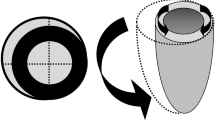Summary
The effects of experimental arteriovenous shunt (AV shunt) on left ventricular dynamics and myocardial mechanics were investigated in female Wistar rats, weighing approx. 240 g. The main goal of the study was to characterize ventricular and myocardial working capacity and to estimate the significance of the various processes involved in cardiac adaptation to the altered loading conditions.
Twelve weeks after operation, systemic blood pressure was slightly elevated in AV shunt rats as compared with age-matched controls, although total peripheral resistance (as related to a common aortic pressure) was significantly reduced. Heart rate and cardiac output were considerably increased. Despite marked left ventricular dilatation with increased end-diastolic and systolic wall stress, no signs of resting insufficiency were present.
Left ventricular weight, end-diastolic volume and pressure, stroke volume, and ejection fraction were increased. The area between the curve of isovolumic maxima and the end-diastolic P-V curve (up to a defined end-diastolic pressure) and the normalized area between the isovolumic and end-diastolic stress-length curves as well as the maximum rate of stress development were augmented, even in the specimen with the highest degree of ventricular dilatation—despite a shift of the myosin isoenzyme pattern towards VM3.
The study reveals that besides the change in ventricular mass and configuration, augmented preload is involved in cardiac adaptation to the altered hemodynamic state. Furthermore, there are indications of an intensified sympathetic stimulation of the heart. Transformation of the myocardium towards a slower muscle seems to be of minor functional significance under the conditions of the present experiments.
Similar content being viewed by others
References
Ross J Jr, McCullagh WH (1964) Nature of enhanced erformance of the dilated left ventricle in the dog during chronic volume overloading. Circ Res 30:549–556
Ross J Jr (1974) Adaptation of the left ventricle to chronic volume overload. Circ Res 34 (Suppl 2) and 35:64–70
Taylor RR, Covell JW, Ross J Jr (1968) Left ventricular function in experimental aorto-caval fistula with circulatory congestion and fluid reaction. J Clin Invest 47:1333–1342
Taylor RR, Covell JW, Ross J Jr (1967) Dissociations between cardiac contractility and congestive failure detected by quantitative analysis of left ventricular muscle function. Circulation 35/36 (Suppl 2):248
Fujisawa A, Sasayama S, Takahashi M, Nakamura M, Ohyagi A, Lee JD, Yui Y, Kawai C (1984) Enhancement of left ventricular contractility after opening of an arteriovenous fistula in dogs. Cardiovasc Res 18:51–59
LeWinter MM, Engler RL, Karliner JS (1980) Enhanced left ventricular shortening during chronic volume overload in conscious dogs. Am J Physiol 238:H126-H133
Nakano J, Schryver CD (1964) Effects of arteriovenous fistula on systemic and pulmonary circulations. Am J Physiol 207 (6):1319–1324
Jacob R (1986) Cardiac responses to experimental chronic pressure overload. In: Zanchetti A, Tarazi RC (eds) Handbook of hypertension. Elsevier, Amsterdam (Pathophysiology of hypertension, vol 7, pp 59–83)
Mercadier JJ, Lompré AM, Wisnewsky C, Samuel JL, Bercovici JB, Swynghedauw B, Schwartz K (1981) Myosin isoenzymic changes in several models of rat cardiac hypertrophy. Circ Res 49:525–532
Rupp H (1982) Polymorphic myosin as the common determinant of myofibrillar ATPase in different haemodynamic and thyroid state. Basic Res Cardiol 77:34–46
Takeda N, Ohkubo T, Takeda A, Nakamura I, Nagano M (1987) Myocardial contractility and left ventricular myosin isoenzyme in chronic volume overloaded cardiac hypertrophy. Basic Res Cardiol 82 (Suppl 2):137–143
Flaim SF, Minteer WJ, Nellis SH, Clark DP (1979) Chronic arteriovenous shunt: evaluation of a model for heart in rat. Am J Physiol 236(5):H698-H704
Noma K, Brändle M, Jacob R (1988) Evaluation of an experimental model of congestive heart failure due to combined arteriovenous shunt and renal hypertension. Basic Res Cardiol 83:58–64
Kissling G, Takeda N, Vogt M (1985) Left ventricular endsystolic pressure-volume relationships as a measure of ventricular performance. Basic Res Cardiol 80:594–607
Vogt M, Jacob R (1985) Myocardial elasticity and left ventricular distensibility as related to oxygen deficiency and right ventricular filling. Analysis in rat heart model. Basic Res Cardiol 80:537–547
Hepp A, Hansis M, Gülch R, Jacob R (1974) Left ventricular isovolumetric pressure-volume relations, “diastolic tone,” and contractility in the rat heart after physical training. Basic Res Cardiol 69:517–532
Jacob R, Vogt M, Noma K (1987) Chronic cardiac reactions. I. Assessment of ventricular and myocardial work capacity in the hypertrophied and dilated ventricle. Basic Res Cardiol 82(Suppl 2):85–93
Hoh JFY, McGrath PA, Hale PT (1978) Electrophoretic analysis of multiple forms of rat cardiac myosin: Effects of hypophysectomy and thyroxine replacement. J Mol Cell Cardiol 10:1053–1076
Stegemann H (1958) Mikrobestimmung von Hydroxyprolin mit Chloramin-T und p-Dimethylaminobenzaldehyd. Hoppe-Seyler's Z Physiol Chem 311:41
Sachs L (1974) Angewandte Statistik. Springer, Berlin Heidelberg New York
Badke FR, Covell JW (1979) Early changes in left ventricular regional dimensions and functions during chronic volume overloading in the conscious dog. Circ Res 45:420–428
Florenzano F, Glantz SA (1987) Left ventricular mechanical adaptation to chronic aortic regurgitation in intact dogs. Am J Physiol 252:H969-H984
Author information
Authors and Affiliations
Rights and permissions
About this article
Cite this article
Noma, K., Brändle, M., Rupp, H. et al. Left ventricular performance in rats with chronic cardiac overload due to arterio-venous shunt. Heart Vessels 5, 65–70 (1990). https://doi.org/10.1007/BF02058319
Received:
Revised:
Accepted:
Issue Date:
DOI: https://doi.org/10.1007/BF02058319




